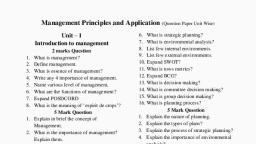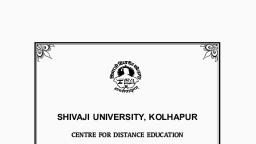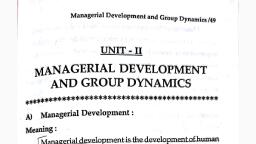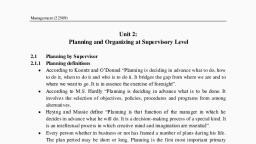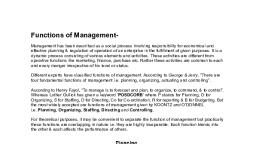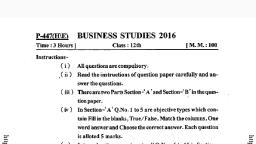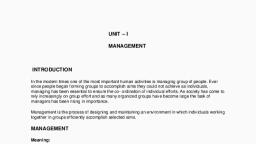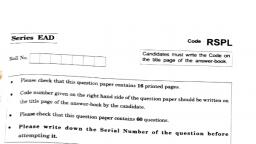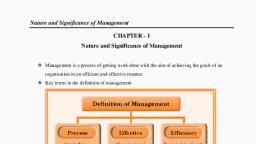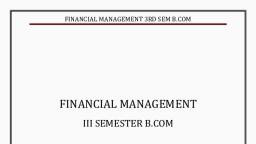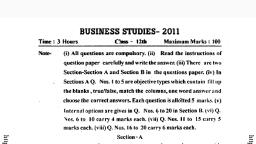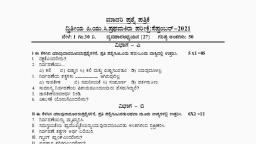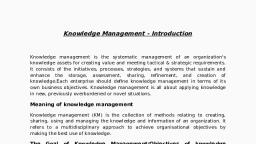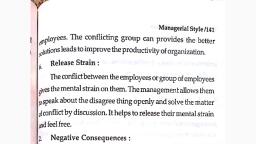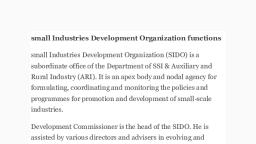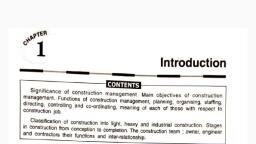Page 1 :
CHAPTER 1, , NATURE AND SIGNIFICANCE OF MANAGENMENT, MANAGEMENT CONCEPT, No organization can work smoothly and efficiently without management. In simple, meaning, management means managing men. But in business, it means managing human and, non human factors. These factors are called inputs or resources. These inputs consist of Men,, material, machines, methods and money. They are popularly known as five M’s of, management., DEFINITION, Management is the art of getting things done through others., It is the process of designing and maintaining an environment in which individuals,, working together in groups, efficiently accomplish selected aims., EFFECTIVENESS AND EFFICIENCY, The performance of a manager is measured by two terms that is effectiveness and, efficiency. Both these aspects need to be balanced. Suppose a company’s target production is, 5000 units, a year. The manager is able to produce 5000 units but at a higher production cost. In, this case, the manager is effective but not efficient. If the manager produces goods at a lower, cost but not achieves the target, the manager is efficient but not effective., CHARACTERISTICS OF MANAGEMENT, i., ii., iii., , iv., , v., , vi., , vii., , Management is a goal oriented process., Every organization has a set of basic goals for its existence., Management is all pervasive, Management is a universal phenomenon and it can be used everywhere., Management is multidimensional, Generally management is a three dimensional activity that are management of, work, management of people and management of operations., Management is a continuous process, It is a never ending process, starts from planning and followed by organizing,, staffing, directing and controlling., Management is a group activity, All organization consists of group of people with different needs. But as a member, of the organization, they work together for the attainment of common goal., It is a dynamic function, Management principles and techniques are dynamic. Management has to make, changes in their goals and objectives according to the changes in the environment., Management is an intangible force
Page 2 :
Sometime management is referred to as intangible /unseen force. But its presence, can be felt by the result., OBJECTIVES OF MANAGEMENT, Objectives of management are summarized into three- that are, i., ii., iii., , Organizational objective, Social objective, Personal objective, , Organizational, , Existence, i., , Profit, , Social, , Personal, , Growth, , Organizational Objective, , Objective set for the organization are called organizational objective. The main, objective of every organization should be maximum result with minimum cost and effort., For that an organization has to achieve its economic objectives are:a) Existence (survival), The basic objective of every organization is to survive. In order to survive it must, earn enough profit., b) Profit, Profit is essential; for survival, growth and expansion of business. It is the reward, of business for bearing risk., c) Growth, The success of an organization is measured by its growth rate. Eg. Increase in, sales. Number of branches, number of employees, number of products etc., ii., , Social Objective, , Every organization is situated in the society and it takes all inputs from the society., Social objective refers to commitment of an organization to the society in which it exists., iii., , Personal Objective
Page 3 :
They are related to the employees of an organization. Management should have the, ability to satisfy different needs of the employees working in the organization- such as, financial needs, social needs, personal growth etc., , Importance Of Management (Advantages), i., , ii., , It helps in achieving group goals, Management direct efforts of all individuals of the organization in a common, direction, for the achievement of organizational objectives., It increase efficiency, By achieving goals with minimum resources, management increases efficiency., , iii., , It creates a dynamic organization, An efficient management enables the organization to adapt to the changing, environment., , iv., , It helps in achieving personal objective, A manager in the organization leads the team by motivating them to achieve the, organizational objective. In doing so, it creates cooperation, team spirit, commitments, etc., , v., , It helps in the development of society, By providing high quality goods and service, employment opportunities,, environment friendly technologies, management helps in the development of the society., , Levels of Management, The hierarchy of different management position from top to bottom is called as levels of, management., , C.E.O, , Top level, , M.D, H.O.D, , Middle level, , Branch Managers, Supervisors, Section, Officers, Foreman, , Low level
Page 4 :
1. Top Level Management, It consists of board of directors, chief executive officers, managing directors,, chairman etc., Functions, a) Formulates policies and plans, b) Organize the business into different departments and appoint department heads., c) Provide direction and leadership to the organization as a whole., d) Coordinates and controls the activities of different departments., e) Maintain relation with government, workers, organizations and other outside groups., 2. Middle Level Management, This level consist of branch managers, heads of the departments etc., Functions, a), b), c), d), e), f), , Implements the policy decision taken by the top management., Transmit orders and instructions to lower level., Communicate suggestions and problems of lower level upwards., Act as a link between top management and lower management., Take department decisions., Guide and inspire lower level managers to attain overall objectives of the organization., , 3. Lower Level Management/Supervisory Level Management, This level includes foremen, supervisors, Accounts officers, sales officers etc., Functions, a), b), c), d), e), f), g), h), , Planning day to day work., Issuing orders and instructions to employees., Arranging materials, machinery, tools etc., Explaining work procedures and supervising the workers., Evaluation of performance., Taking corrective action if necessary., Sending reports to higher authorities ., Communicating the grievances and suggestions to higher authorities., , Functions of Management
Page 5 :
The activities perform by a manager are called functions of management. These are, planning. organizing, staffing, directing and controlling., , 1.Planning, It means deciding in advance what to do and how to do it. It is a process of thinking, before doing ie thinking about what is to be done tomorrow., , 2.Organising, Identification and grouping of activities to be undertaken in the organization for, achieving specific objectives is called organizing. It is a process of establishing relationships, among the members of the organization. It is a process of arranging everything in an orderly, manner for the attainment of organizational objectives., , 3.Staffing, It refers to hiring and developing requiring personnel to fill various position in the, organization. It is the process of ‘putting people to various jobs.’ It is the process of selecting, people for the execution of jobs, training them and appointing them in the right place. The, department which performs the staffing function is known as human resource department (HR)., , 4.Directing, It is the process of instructing, guiding, counseling, motivating and leading people in an, organization to achieve its objectives. Planning, organizing and staffing are preparatory, functions., Directing starts when the actual works starts.
Page 6 :
5.Controlling, It is the process of ensuring that activities of personnel and use of resources are in, conformity with the standards. It means examining that everything goes according to the plans., , Nature of Management, Management experts have different views on the nature of management. Some say it is an, art and others say it is a profession., , 1 .Management as a science, Some management experts say that management has some unique features in common, with science., Features of Science are :1. Systematic body of knowledge, Science is a systematized body of knowledge developed after long years of scientific, methods of observations. Management also satisfies these features as it has a systematized body, of knowledge., , 2. Principles based on Experimentation, Scientific principles are formulated on the basis of continuous, observations and, experiments. Management satisfies this feature but the outcome cannot be predicted, because, management deals with human beings., 3. Principles are Universally Applicable, Scientific principles can be applied in all situations and all times as management, principles are not as exact as principles of science, they cannot be considered universal in, character., 4. Cause-effect Relationship, Principles of science establish a cause effect relationship between various factors. In, management principles it also establishes cause effect relationship, but not completely., Some principles of science are not seen in management. Therefore it is not possible, to say that management is an exact science like physics or chemistry. As management is, related to man we can say management is a social science., , II .Management is an art
Page 7 :
Art is the application of knowledge and personal skills to achieve desired result with, efficiency., , Features of Art are, 1. Personal Skill, Each artist has his own style and approach. Same is true in case of managers also., 2. Practical Knowledge, A person cannot become a successful manager by simply having good theoretical, knowledge. He must have practical knowledge also. So this feature of art is present in, management., 3. Concrete Result, Like an artist, every manager applies his skill and knowledge to attain the desired result., 4. Perfection through practice, Every artist becomes more efficient through constant practice. Similarly a manager gains, experience and improves through regular practice of management., Some principles of the art are not seen in management. As management has, matched with other features of art in common , we can say that management is an art., , III. Management is a profession, Profession is an occupation supported by specialized knowledge, training and skill. Its, features are:1. Well defined body of knowledge, Like profession, management has a systematic body of knowledge built up by, management practitioners and thinkers over a period of time., 2. Formal Training, Profession needs formal training and experience. Several educational institutions all over, the world offer facilities for training in management., 3. Restricted Entry, Entry to a profession is restricted through an examination. However in practice no, qualification is prescribed to become a manager., 4. Professional Association
Page 8 :
In every profession there is a representative body. But it is not compulsory for managers, to be members of a management association., 5. Code of Conduct, Members of a particular profession have to follow the rules and regulation prescribed by, the association. But in management, there is no uniform code of conduct., 6. Service Motive, Profession involves the application of expert knowledge for the benefit of the society., Management is expected to function efficiently at the lowest cost so as to serve the interest of, employers, employees, consumers, suppliers, society etc., , Co-ordination, Co-ordination is the process of integrating the activities of different units of an, organization to achieve the organizational goals. Co-ordination is considered as the essence of, management and it is needed at all levels of management., , Importance of Co-ordination, 1. Co-ordination is the essence of Management, Co-ordination is very essential in planning. Sub plans of different departments are, connected to the master plan through co-ordination., The authority, responsibilities and duties of an organization are brought together through, co-ordination. Co-ordination is necessary in staffing process. It is also required between, superior and sub-ordinates, between orders, instructions etc., 2. Co-ordination is essential at all levels of management, Top level management integrates the efforts of each individual through co-ordination., The work of different departments is linked with top management through co-ordination. In, lower level, co-ordination makes it possible to link the activities of employees towards the, achievement of organizational objectives., , Elements of Co-ordination, 1. Integration, Integrating or unification of unrelated activities to a common direction, 2. Balancing, Balancing the activities of different departments to achieve common goal., 3. Timing
Page 9 :
Examining whether the activities of the organization as completed as per the time, schedule or note., , Co-ordination and Co-operation, Co-ordination and co- operation are different., Co-operation is voluntary attitude on the part of the members, while co-ordination is a, deliberate effort on the part of the manager., Co-operation is the base on which co-ordination can be achieved., Co-operation originates from informal relationship. Co-ordination is accomplished, through formal relationship., , Features or Nature of Co-ordination, 1. Essence of Management, Co-ordination is present in each function of management and required at all levels and in, all departments., 2. Continuous Process, It is a continuous process carried on by all the levels of management., 3. Group Effort, Co-ordination applies to a group and not an individual effort., 4. Unity of Effort, It brings unity of action among various departments and inter departments activities of, an organization., 5Common purpose, Co-ordination has a common purpose of getting organizational goals achieved., 6. Deliberate Effort, Co-ordination is not voluntary. A manager has to co-ordinate the efforts of different, people in a conscious and deliberate manner.
